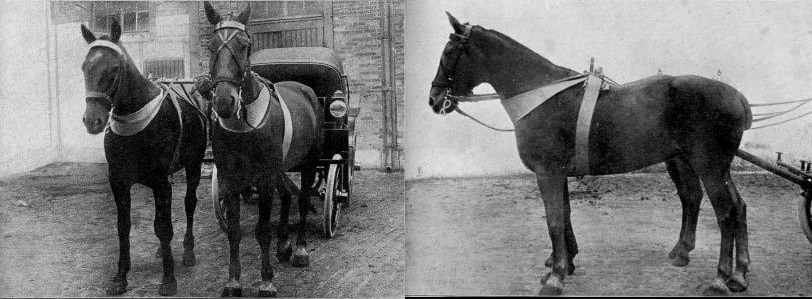Before discussing the major harness systems of the Roman era, I want specifically to examine how Lefebvre des Noëttes' interpretation based on his study of the iconography It is his perception of the harness system which is at the heart of the debate.
Lefebvre des Noëttes believed that traction was by the throat1.
The collar, the principal organ of traction, was a large band of supple leather which encircled the neck like a dog collar putting pressure on the windpipe. It was attached to a yoke by leather straps. It did not have the least contact with the shoulder bone2.
The yoke itself, a second main component of the system, was a straight or curved bar of wood which rested on top of the withers [sur le garrot/au-dessus du garrot] and was held in place by a girth3. This ancient harness which Lefebvre des Noëttes described is sometimes called a "throat and girth harness." It was this vision of ancient harness which the Commandant reconstructed for his experiments in 1910.

Fig. 1: Photographs of Lefebvre des Noëttes 1910
experiment.4
This also represents the type of harness which Lefebvre des Noëttes believed existed throughout the ancient world.
We now know, thanks to archaeology, that this reconstruction is false. In reality there were two main types of harness used in the period of the Roman Empire: dorsal yoke and neck yoke. The reconstruction and experiment by Lefebvre des Noëttes combined these two types of systems and created a third which did not exist in reality5. Because of this great mistake all assumptions made by Lefebvre des Noëttes must be rendered false as must all suppositions which flow from using this false premise.
Horse harness in the ancient world can be divided into two basic types: 1. Dorsal Yoke 2. Neck Yoke6. The tandem hitch was also known and frequently used in the Ancient world, but was still a variation on the two major systems.
For much of antiquity the harness system used was that of the dorsal yoke. This was the system used by the Greeks, and the Romans in the Mediterranean area. The neck yoke, which was unique to the Gallo-Roman area, appears to have existed only during the period of the Late Roman Empire. Professor George Raepsaet has published numerous papers discussing this singular type of harness. It was, nevertheless, not the predominant harness system during any period in Rome's history. The predominant system was always the dorsal yoke.
Fig 2.: Drawings demonstrating various traction systems in Roman Imperial times as compared with that of Lefebvre des Noëttes7
- Lefebvre des Noëttes, 1924, p. 8
- Ibid.
- Ibid.
- Ibid., Fig. 1 and 2 following p.132.
- Raepsaet, 1979, pp. 271-272; Spruytte, 1983. Scholars who have seriously studied this area now accept the falsity of Lefebvre des Noëttes' experiment and its ensuing premise.
- Raepsaet, 1979; Spruytte, 1982
- Spruytte, pp. 13-15. Additional notes on the drawings, which are in color have been added by the author to better illustrate the points made.